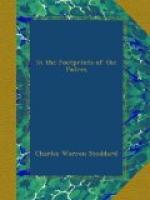In those days there were at least four foreign quarters—Spanish, French, Italian, and Chinese. We knew the Spanish Quarter at the foot of the hill by the human types that inhabited it; by the balconies like hanging gardens, clamorous with parrots; and by the dark-eyed senoritas, with lace mantillas drawn over their blue-black hair; by the shop windows filled with Mexican pottery; the long strings of cardinal-red peppers that swung under the awnings over the doors of the sellers of spicy things; and also by the delicious odors that were wafted to us from the tables where Mexicans, Spaniards, Chilians, Peruvians, and Hispano-Americans were discussing the steaming tamal, the fragrant frijol, and other fiery dishes that might put to the blush the ineffectual pepper-pot.
Everywhere we heard the most mellifluous of languages—the “lovely lingo,” we used to call it; everywhere we saw the people of the quarter lounging in doorways or windows or on galleries, dressed as if they were about to appear in a rendition of the opera of “The Barber of Seville,” or at a fancy-dress ball. Figaros were on every hand, and Rosinas and Dons of all degrees. At times a magnificent Caballero dashed by on a half-tamed bronco. He rode in the shade of a sombrero a yard wide, crusted with silver embroidery. His Mexican saddle was embossed with huge Mexican dollars; his jacket as gaily ornamented as a bull-fighter’s; his trousers open from the hip, and with a chain of silver buttons down their flapping hems; his spurs, huge wheels with murderous spikes, were fringed with little bells that jangled as he rode,—and this to the accompaniment of much strumming of guitars and the incense of cigarros.
Near the Spanish Quarter ran the Barbary Coast. There were the dives beneath the pavement, where it was not wise to enter; blood was on those thresholds, and within hovered the shadow of death. Beyond, we entered Chinatown, as rare a bit of old China as is to be found without the Great Wall itself. Chinatown has grown amazingly within the last forty years, but it has in reality gained little in interest. There is more of it: that is the only difference; and what there is of it is more difficult of approach. The Joss House, the theatre, with its great original “continuous performance”—its tragedy half a year in length,—flourished there. The glittering, spectacular restaurant was wide open to the public, and so was everything else. That fact made all the difference between Chinatown in the Fifties and Chinatown forty years later.
My companion and I tarried long on Dupont Street, between Pacific and Sacramento Streets. The shops were like peep shows on a larger scale. How bright they were! how gay with color! how rich with carvings and curios. Each was like a set-scene on the stage. The shopkeepers and their aids were like actors in a play. They seemed really to be playing and not trying to engage in any serious business.




